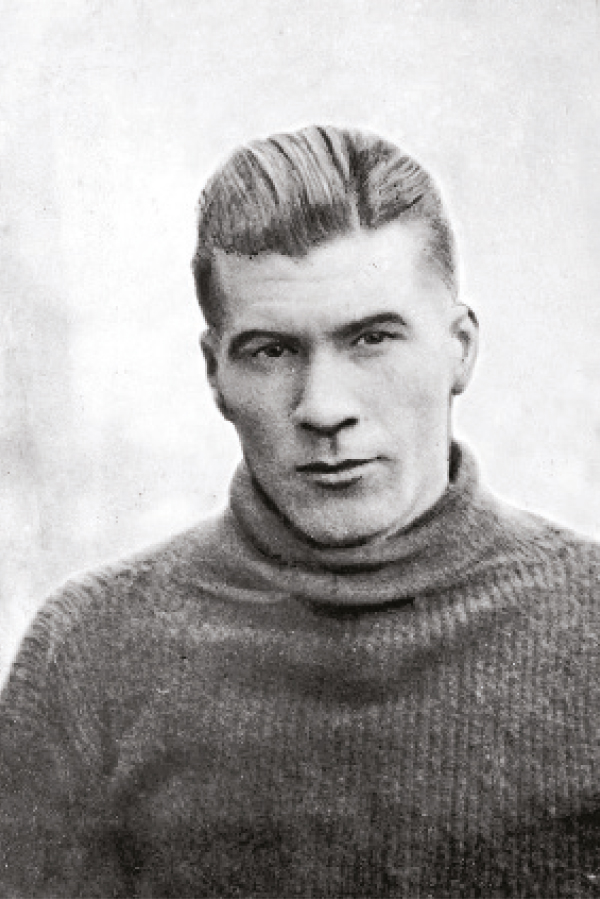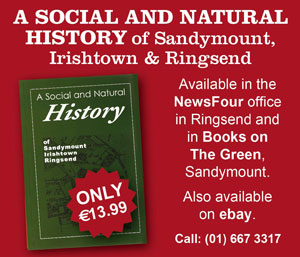
Elisha Scott: Ireland and Liverpool goalkeeper
By Gavan Bergin
Elisha Scott was born in 1893 and grew up in the Donegall Road area of Belfast. He was raised in a large, football-mad family. Two of his older brothers played international football for Ireland. Tom Scott was Ireland’s goalkeeper between 1894 and 1900, then Billy Scott did the job from 1903 until 1913, by which time, Elisha was looking like he might well become the third Scott brother to be Ireland’s Number One.
He showed no interest at all in football until he started playing as a centre-forward for his local boys’ team in 1906. He played as a striker and he did very well at it, scoring plenty of goals for the team.
The story goes that the change from playing up front to playing in goal happened because the previous keeper was so bad at keeping the ball out that he was letting in even more goals than were being scored by Elisha – who reckoned he could hardly be any worse in nets himself and gave it a go. From the start, he looked like a natural-born goalkeeper.
In 1910, when he was sixteen, Elisha signed a professional contract with the Belfast junior club Broadway United. Within a couple of seasons, he was considered one of the best young keepers in Ireland.
In the spring of 1912, Elisha went to England to play a trial match with Everton, who passed on him because they thought he was too small. Elisha, at 5’9” was never going to be the tallest goalie in the world, but his lack of size didn’t put off Liverpool, who signed him in September 1912.
Elisha made his debut for Liverpool against Newcastle on January 1st, 1913, and played a great game that earned him praise in the Liverpool Echo, which said: “Hats off to Elisha Scott, Liverpool’s youthful guardian, whose debut was brilliant – and a pleasing augury”.
Despite that praise, he waited on the sidelines for a full year and it was not until early in the 1914/15 season that he got another chance. From then on, he started getting regular games, playing to such a high standard that it soon became clear that he was far too good to be a mere back-up and by the second half of the season, Elisha was Liverpool’s first-choice goalkeeper. He had the number one jersey at last and had every intention of holding on to it.
Elisha was still only 22 years old, but with his brilliantly exciting style of play and his distinctively dashing appearance on the field, he was already establishing himself as a unique character in the game who would become part of Liverpool folklore.
Contemporary newspaper reports describe a striking figure, a slender, sharp-featured man, clad in his trademark black jersey and radiating a deeply intense focus as he did his job.
His mental toughness was allied with almost the perfect physical attributes for a goalie. He had quick, strong hands, staggeringly swift reflexes, and when the ball was in the air, he would leap for it with such grim determination that even the biggest of opposing forwards would sometimes hesitate to contest for the next cross that went into his area.
The Evening Herald said, “when he went for the high crosses, woe betide anyone who got in his way”. Forceful and deft, he presented a vision of perfectly balanced action, a dark streaking blur of gracefulness that earned him his nickname – The Black Panther.
Elisha became renowned in football, not only for his appearance and character, nor just for his astounding feats in matches, but also for his professionalism and attention to detail in devising his own personal training regime that focused on fitness and the sharpening of the very specific skills required of a goalkeeper.
An example of his inventive approach was the unique, solo, warm-up routine he adhered to throughout his career. The author Dean Lyons in his profile of Elisha describes how “even in the summer, Scott would wear two or three jerseys and a couple of pairs of shorts pulled over long-johns and knee-pads, which would be donned at least an hour before kick-off, and he would then spend that time hurling a ball against the dressing room wall to practice his catching. It was typical of a man who was a perfectionist and who helped turn goalkeeping into a fine art.”
In the summer of 1915, having just established himself as Liverpool’s number one, Elisha was undoubtedly looking forward to the start of the new season in August 1915. But there would be no new season. English football was suspended due to the First World War.
Elisha went home to Ireland to play for Belfast United and Linfield, then joined Belfast Celtic in 1916. He spent the next three years there, earning his first major medals by helping Celtic win the Irish Cup in 1918 and the Irish League in 1919.
By then, English football was restarting and Elisha went back to Liverpool. They were on their way to becoming a power in the English league for the first time and Elisha was a major factor in that rise.
The early 1920s saw him entering his heyday as a player. Liverpool won the League two years in a row, in 1922 and 1923, with Elisha hardly missing a game during both championship seasons.
It was a great time for Liverpool, their city rivals Everton were getting stronger due in part to the emergence of a footballer who would become their finest ever player, Dixie Dean. An intense and fascinating rivalry developed between Dixie and Elisha, which produced anecdotes that are still discussed on Merseyside.
One such story tells how, when Elisha and Dixie encountered one another one evening out walking on the same street in Liverpool city centre, and as they were about to cross paths, Dixie politely nodded his head in greeting, and Elisha, quick as a flash, made as if to dive to save the imaginary header. It is said that crowds of people were brought to a standstill when they witnessed this odd exchange between two of the most famous people in the city, and after initial stunned silence the onlookers broke out in smiling, laughing applause.
It may or may not have happened like that, but the yarn is a good one and it does perfectly illustrate the contrasting public characters of the two great rivals: Dixie the quietly reserved Englishman; and Elisha the exuberant, unconventional and eccentric, Irishman. There would be many more encounters between the two in the lead up to derby matches for years to come, and discussion among fans and media often centred on which of the two would come out on top.
Although the two players were good friends off the pitch, on it their rivalry burned fierce and bright, and it never faded or dimmed as the two of them went at one other, with no quarter asked or given, in derby match after derby match, right up until the time Elisha left Liverpool, in 1934.
His departure came about because the club’s management, with an eye on the future, had been leaving Elisha, in his forties by then, out of the team in favour of younger players. But despite his age, he was a long, long way from being finished as a player, and certainly wasn’t the kind of man to be content just picking up his pay packet for sitting on the bench at Liverpool. So, after 21 years with the club, Elisha left to join Belfast Celtic as player-manager.
In Belfast, he went on to show that, as well as still having the goods as a keeper, he had all the skills required to be a top-notch manager. Just as he had been ahead of his time in his approach to training as a player, he was similarly forward-thinking in his coaching methods. He trained his players just as hard as he had trained himself, greatly improving their stamina and fitness and got the team playing a fantastically effective style of football.
Within a couple of years, he was guiding Belfast Celtic through the greatest era in their history.
Part two, to be continued in our next issue…



